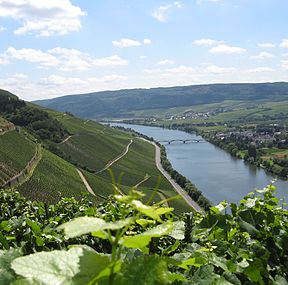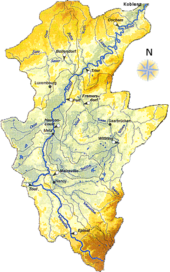- Moselle (river)
-
This article is about the river in France, Luxembourg, and Germany. For the river in England, see River Moselle (London).
Moselle 
Typical landscape of Mosel vineyards near SchweichOrigin Vosges mountains Mouth Rhine
50°21′58″N 7°36′25″E / 50.36611°N 7.60694°ECoordinates: 50°21′58″N 7°36′25″E / 50.36611°N 7.60694°EBasin countries France, Germany, Luxembourg Length 545km Source elevation 715 m Avg. discharge 290 m³/s Basin area 28,286 km² The Moselle (French: Moselle, IPA: [mɔzɛl]; German: Mosel; Luxembourgish: Musel) is a river flowing through France, Luxembourg, and Germany. It is a left tributary of the Rhine, joining the Rhine at Koblenz. A small part of Belgium is also drained by the Mosel through the Our.
Its name comes from the Latin Mosella, meaning the "Little Meuse" (Mosa in Latin). The river gave its name to two French départements: Moselle and Meurthe-et-Moselle.
Contents
Geography
The source of the Moselle is at the western slope of the Ballon d'Alsace in the Vosges mountains. The Moselle flows through the Lorraine region, west of the Vosges. Further downstream, in Germany, the Moselle valley forms the division between the Eifel and Hunsrück mountain regions. Its total length from source to mouth is approximately 546 km.
Towns along the Moselle River are:
- in France: Épinal, Toul, Pont-à-Mousson, Metz, and Thionville
- in Luxembourg: Schengen, Remich, Grevenmacher, and Wasserbillig
- in Germany: Trier, Bernkastel-Kues, Cochem, and Koblenz
Literature
The Moselle was celebrated in Mosella, an ancient Roman poem by Ausonius. In the twentieth century, the river and the folklore and local history of the towns along its banks were described by British travel writer Roger Pilkington. In the tale, "The Seven Swabians" of the Brothers Grimm, the eponymous Swabians drown trying to cross the Moselle.
Tributaries
 Bernkastel-Kues, a famous picturesque old town at the Moselle
Bernkastel-Kues, a famous picturesque old town at the Moselle
From the left: Madon, Terrouin, Esch, Rupt de Mad, Orne, Fensch, Gander, Syre, Sauer, Kyll, Salm, Lieser, Alf, Endert, Brohlbach, Elz.
From the right: Moselotte, Vologne, Meurthe, Seille, Saar, Olewiger Bach, Avelsbach, Ruwer, Feller Bach, Dhron, Ahringsbach, Kautenbach, Lützbach, Flaumbach, Altlayer Bach, Baybach, Ehrbach.
Economy
The Moselle valley between Nancy, Metz and Thionville is an industrial area, with coal mining and steel manufacture.
The Moselle valley is famous for its beautiful scenery and the excellent wine produced. Most well-known is the German Mosel wine region, while the Luxembourgish winegrowing region is called Moselle Luxembourgeoise and the French region is called VDQS Moselle. Most notable among the wines produced here are Riesling, Elbling, Müller-Thurgau, Kerner and Auxerrois. The German part of the Moselle is a popular tourist destination. An important asset is today's Moselradweg, the 311 km (193 mi) long cycleway from Metz to Koblenz, which also connects to nine other cycleways.
 Moselle flowing through Metz
Moselle flowing through Metz
 Cochem Castle, overlooking the river Moselle
Cochem Castle, overlooking the river Moselle
The Moselle has been made navigable for large cargo ships (up to 110 m in length[1]) from the Rhine in Koblenz up to Neuves-Maisons, south of Nancy. For smaller ships it is connected to other parts of France through the Canal de l'Est and the Canal de la Marne au Rhin. There are locks in Koblenz, Lehmen, Müden, Fankel, Sankt Aldegund, Enkirch, Zeltingen, Wintrich, Detzem, Trier, Grevenmacher, Palzem,[1] Apach, Kœnigsmacker, Thionville, Richemont, Talange, Metz, Ars-sur-Moselle, Pagny-sur-Moselle, Blénod-lès-Pont-à-Mousson, Custines, Pompey, Aingeray, Fontenoy-sur-Moselle, Toul, Villey-le-Sec, and Neuves-Maisons.[2]
Castles
- Château de Malbrouck: near Manderen, this castle was built in the 15th century but rebuilt in the 1990s. Today it is used for numerous cultural events.
- Château Fort du Sierck-les-Bains: situated just on the French-German border at Sierck-les-Bains, this fortress of the Duke of Lorraine dates back to the 11th century. Most of today's castle was constructed in the 18th century, following plans from Vauban.
- Schloss Berg: a Renaissance castle at Nennig, today a hotel and a casino.
- Alte Burg: a manor house built in 1360 at Longuich. One of the few surviving manor houses in rural Rhineland-Palatinate.
- Schloss Lieser: a palace at Lieser built from 1884 to 1887 in historistic style.
- Burg Landshut: a castle built by the Electorate of Trier in the 13th century at Bernkastel-Kues.
- Grevenburg: ruins of a castle at Traben-Trarbach built by Johann III of Sponheim-Starkenburg about 1350, destroyed, after many sieges, in 1734.
- Marienburg: a 12th-century castle and later monastery near Pünderich and Alf.
- Burg Arras: a 12th-century castle in Alf.
- Burg Metternich: a castle built around 1120 at Beilstein, today partly in ruins.
- Castle of Cochem: The castle in Cochem was originally built in the 11th century, but was completely destroyed by French soldiers in 1869. The present castle was rebuilt later in the 19th century.
- Burg Thurant: Above the town of Alken is Thurant castle, built in the 13th century. It is the only twin-towered castle along the Moselle.
- Ehrenburg: a 12th-century castle built by the Electorate of Trier at Brodenbach.
- Burg Eltz: The von Eltz family castle, whose history dates back to the 12th century. It remains in private hands to this day but it is open to visitors.
- Lower and Upper Castle, Kobern-Gondorf: two 11th-century castles, today mostly in ruins.
- Burg Pyrmont: This 13th-century castle near Roes was remodelled and extended several times during the Baroque era.
- Burg Bischofstein: Across the river from the municipality of Burgen is this 13th century castle, which was destroyed during the Nine Years' War, but was reconstructed and now serves as a retreat centre for the Fichte Gymnasium in Krefeld.
See also: Wikimedia Commons - Castles in Rhineland-Palatinate
See also
References
External links
- mosel.de, mosel.de
- Die Mosel, die-mosel.de
- Moseltal, moseltal.de
- www.mosel.com, mosel.com
- HoloGuides - Moselle, hologuides.com
- Bibliography on Water Resources and International Law Peace Palace Libray at ppl.nl
- Livecam Moselle river, webcam.cochem.c
- German-Luxembourgish-French Mosel Agency (in German/French)
- German Waterways Agency Trier (Wasser- und Schifffahrtsamt Trier) (in German)
Left (western) Alpine Rhine: Vorderrhein · High Rhine: Thur · Töss · Glatt · Aare · Sissle · Ergolz · Birs · Birsig · Upper Rhine: Ill · Moder · Sauer · Lauter · Spiegelbach · Queich · Speyerbach · Rehbach · Isenach · Eckbach · Eisbach · Pfrimm · Selz · Middle Rhine: Nahe · Moselle · Nette · Brohlbach · Ahr · Lower Rhine: Erft
Right (eastern) Alpine Rhine: Rein da Tuma · Rein da Curnera · Rein da Medel · Glenner · Rabiusa · Hinterrhein · Plessur · Landquart · Ill · Frutz · Lake Constance: Dornbirner Ach · Bregenzer Ach · Leiblach · Argen · Schussen · Rotach · Linzer Aach · Stockacher Aach · Radolfzeller Aach · High Rhine: Biber · Wutach · Alb · Alb · Wehra · Upper Rhine: Wiese · Elz · Kinzig · Rench · Acher · Murg · Alb · Pfinz · Saalbach · Kraichbach · Leimbach · Neckar · Weschnitz · Modau · Main · Middle Rhine: Wisper · Lahn · Wied · Lower Rhine: Sieg · Wupper · Düssel · Ruhr · Emscher · Lippe · IJssel: Oude IJssel/Issel · Berkel · SchipbeekCategories:- Rivers of Luxembourg
- Rivers of Rhineland-Palatinate
- Rivers of Saarland
- Rivers of France
- Grevenmacher
- Remich
- Moselle basin
- Rhine basin
- Germany–Luxembourg border
- International rivers of Europe
Wikimedia Foundation. 2010.

